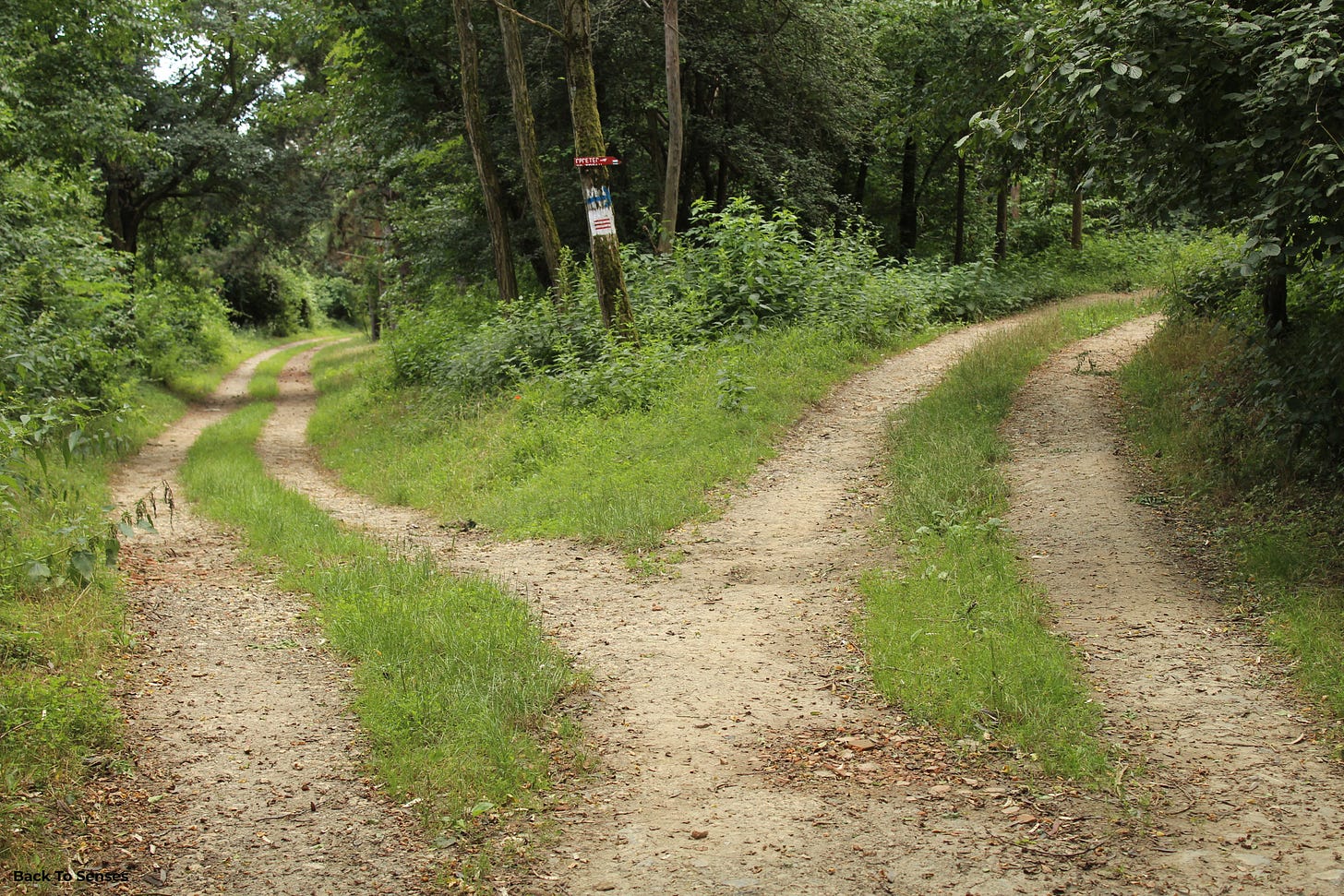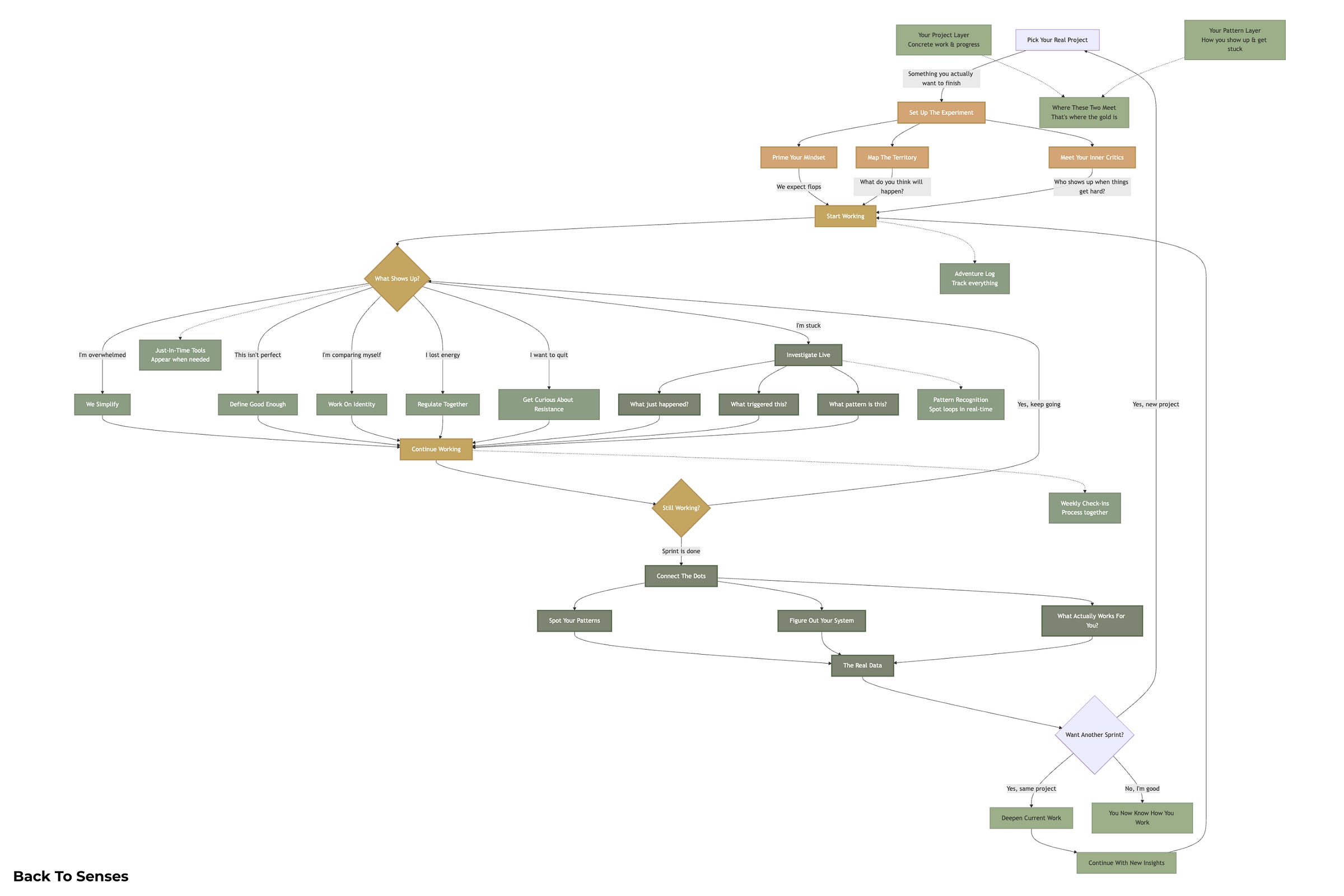Some people have an idea and… just do it. Others, maybe you, don’t.
Not for lack of trying or talent. But because something always seems to get in the way: a better idea. Or a worse mood. Or overthinking. And some shame.
A spike of enthusiasm followed by a mysterious fog.
You want to build something real, but instead you're spinning, moving in circles.
You stay busy, but instead of a cohesive arc, you’re left with scattered vignettes. Starts and stops. Moments of clarity, inspiration, momentum… then nothing.
And with every abandoned idea, a little more self-trust slips away.
You know what’s going on. You can name the patterns. You’ve read the books.
Hell, you could write the books. But somehow, insight doesn’t lead to action.
The gap between what you know and what you do only grows.
So, yes: some people have an idea and just... do it. They sketch something out, hit publish, launch the thing. It's not perfect, but it's real. It exists in the world.
Others get caught in something else entirely.
You have the idea, get excited, start planning.
You research and refine. You imagine how it could work, how it could grow, how it could matter. And then... something happens. You get serious about it. The energy shifts. The project gets heavy. Before you know it, you find yourself procrastinating, or pivoting to a "better" idea, or just quietly letting it fade into your endless collection of almosts.
It’s not about motivation, either. You're hardly sitting around doing nothing. In fact, you're probably always busy with something: reading, learning, thinking, planning. It's just that none of it ever becomes something tangible and cohesive. It's a bunch of life vignettes: starts and stops, twists and turns.
If this sounds familiar, you're dealing with what I call being "smart but stuck."
The Real Problem: Everything Feels Like a Threat
Here's what's actually happening: somewhere along the way, your work became an extension of yourself.
Your projects aren't just projects - they're referendums on your worth, your intelligence, your value as a person. They are the extension of you.
When your identity is wrapped up in your output, everything becomes dangerous. Shipping something imperfect doesn't just mean the work might not land well—it means you might not be good enough.
Getting criticism doesn't just mean the project needs work—it means you're exposed, vulnerable, potentially humiliated.
Because, in your head, someone is always watching your every move like a hawk. And they better be impressed or else.
And so your system does what any rational system would do when faced with threat: it protects you. It delays. It perfects. It researches more, plans more, thinks more. It keeps you safely in the realm of potential rather than risking the messy reality of actual results.
It's just your nervous system doing its job.
The problem is that what feels safe in the short term—staying in planning mode, avoiding judgment, keeping things private—keeps you stuck in the long term.
The Safety Trap
Somehow along the way, you've learned to equate uncertainty with danger.
You treat every unknown as a risk to be eliminated rather than information to be gathered. You approach your creative work like you're defusing a bomb instead of planting a garden.
This shows up in predictable ways:
You research endlessly before starting anything, trying to eliminate all possible failure points. You revise and refine forever, never quite ready to let anyone see the work. You abandon projects the moment they stop feeling guaranteed to succeed. You pivot constantly, always looking for the "safer" path forward.
But here's the paradox: the more you try to eliminate risk, the more risk you actually create. While you're planning the perfect approach, other people are learning by doing. While you're waiting for certainty, the world is changing around you. While you're protecting yourself from small failures, you're guaranteeing yourself a much larger one: never actually finishing anything that matters.
Lost in the Weeds of The Messy Middle
You've been taught it’s safer to make detailed maps before you walk anywhere.
Plan the route. Anticipate the obstacles. Know where you're going before you start.
But here's the thing: we live in a world of "wicked problems"1: complex, shifting challenges that can't be solved with a neat plan. The territory keeps changing. Your carefully drawn map becomes obsolete before you've taken ten steps.
Meanwhile, the people who are actually getting things done are not spending months perfecting their maps. Instead, they're walking the territory. Learning by doing. Adjusting as they go.
This isn't because they're reckless or less thoughtful than you. It's because they've learned something you haven't: uncertainty isn't a problem to solve. It's a condition to navigate.
But all that requires a sense of safety and hope that you’ll be fine, regardless of the outcomes.
Why the Standard Approach Makes Things Even Worse
When smart-but-stuck people try to get unstuck, they usually reach for more of what got them stuck in the first place: better systems, clearer goals, more detailed plans.
The productivity world is happy to oblige. Set SMART goals. Break everything into milestones. Use this app, try this method, follow this framework. The promise is always the same: if you just organize it right, you'll finally follow through.
But this is like trying to solve an emotional problem with a technical solution. It's like trying to fix feeling overwhelmed by adding more items to your to-do list. You don’t need to focus on getting rid of the overwhelm - you first want to understand what caused it.
Here's why the standard approach backfires often:
It treats symptoms, not causes. You're not procrastinating because you need a better calendar app. You're procrastinating because something about moving forward feels unsafe, uncertain, or threatening to who you think you need to be.
It adds pressure instead of removing it. When you set goals and deadlines and milestones, you're not creating motivation. You're creating pressure. And pressure, for most people whose work feels personal, doesn't lead to action. It leads to analysis paralysis.
It ignores your actual operating system. You're not a machine that just needs better programming. You're a human with a nervous system that responds to perceived threats by either fighting, fleeing, or freezing. Most productivity advice completely ignores this reality.
It reinforces the identity trap. By focusing on outcomes and achievements, it keeps you locked in the mindset that your worth depends on your output. This is exactly what got you stuck in the first place.
The standard approach tries to force you into submission using discipline and shoulds. But most people never tap into their potential not because they don't try hard enough, but precisely because they are trying too hard.
The Adventure Approach
Instead of treating your projects like problems to solve, what if you treated them like territories to explore?
Instead of setting goals and crossing your fingers that this time will be different, what if you made exploration itself the only goal?
This is what I call the Adventure Approach. It's not about reaching a destination—it's about having an interesting journey. And like any good adventure, the point isn't to avoid uncertainty. The point is to get comfortable with it.
Here's how it works:
You separate yourself from your work. The project isn't you. It's something you're making. If it doesn't turn out perfectly, that doesn't mean you're not good enough. It means you learned something. You’re doing the work because you want to create, share, express. That means operating from abundance, not scarcity.
You expect messiness. Instead of trying to eliminate uncertainty, you plan for it. You know things won't go according to plan, so you build flexibility into the process instead of trying to force reality to match your blueprint.
You treat resistance as information. When you hit a wall—when you start procrastinating, or doubting, or wanting to quit—you don't see it as failure. You see it as data. What is this resistance trying to tell you? What are you protecting yourself from? Instead of resisting resistance, you invite it for a drink and listen to what is has to tell you.
You prototype instead of predicting. Rather than trying to figure everything out in your head, you test small pieces in the real world. You build tiny experiments. You try things and see what happens.
You measure success by learning, not completion. The goal isn't to finish the project exactly as planned. The goal is to learn something real about yourself, your process, and what actually works for you.
It’s not about lowering your standards or settling for mediocrity but simply recognizing that the path to anything worthwhile is messy, nonlinear, and requires you to be okay with not knowing how things will turn out.
It’s Kind of Urgent
In today's world, we need to move fast and adapt quickly. We need to be able to act without perfect information. But the certainty that smart-but-stuck people desperately seek is nowhere to be found. Waiting for it to land on your lap is a waste of time.
Everything is changing constantly. AI is reshaping entire industries. The economy is volatile. Social structures are shifting. The old playbook—plan carefully, execute perfectly—doesn't work when the rules keep changing.
Meanwhile, the need for safety and certainty that characterizes smart-but-stuck people clashes directly with the demand for speed and adaptability.
It's never been easier to bring ideas to life, and it's never been harder to know which ideas are worth pursuing.
This creates a paralyzing paradox: you need to act quickly, but you want to act correctly. You need to experiment, but you hate the thought of wasting effort. You need to adapt, but adaptation requires letting go of your carefully constructed plans.
The adventure approach resolves this paradox. When exploration is the goal, there's no such thing as failure, only data. When you're walking the territory instead of following a map, you can change direction without starting over. When your worth isn't tied to your output, you can afford to try things that might not work.
But that requires a lot of… unlearning and rewiring. And that only happens in action.
The territory is waiting and it's a lot more interesting than any map could ever be.
Curious what mine looks like these days? Well, here’s what I’m busy with, in a nutshell:
Wicked problems are complex, interconnected issues that are difficult to define and solve due to their multifaceted nature, incomplete information, and changing requirements. They are often characterized by a lack of a single, definitive solution and may have unintended consequences.







https://music.apple.com/us/album/nothing-compares-2-u-live-at-siriusxm-2015/1436558289?i=1436558851
Always consider that some problems require a complete reframing of norms to
Solve.
Doesn’t mean you are wrong. Likely just that you are early.
And it’s lonely being early…